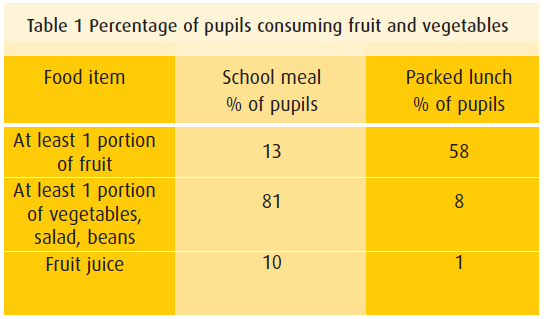School meals vs. packed lunches in UK
Background
In England the government announced new standards for school meals in 2006 and these have been gradually phased in. In September 2006, interim food-based standards were introduced and the final food and nutrient-based standards were brought in for primary schools in September 2008 and a year later for secondary schools1. However many children prefer to take a packed lunch to school and so their lunchtime meal will not be covered by the new standards and indeed in 2008-09 only 39% of primary school children had a school meal2. With large Numbers of children bringing food in from home, it is important that packed lunches also follow healthy guidelines.
A study to investigate the nutritional intake of children at lunchtime
We designed a study to investigate the nutritional intake of children at lunchtime in four primary schools in the South West of England3. We compared the intake of children who consumed school meals with those who brought in packed lunches from home. Schools were surveyed in November and December 2006 (after the introduction of the interim food-based standards).
Children were chosen at random from class lists of those children for whom informed consent had been granted. Approximately equal numbers of girls/boys, packed/school lunch were chosen and all were aged between 6-11 years. Participants were observed once at a meal time and the food items consumed or wasted were recorded. Portion sizes were estimated using household measures with help from the catering staff and using the portion size guide on the nutrient analysis programme, CompEat.
More fruits in packed lunch and More vegetables in school lunch
Of the 120 pupils that took part, 62 had school meals and 58 had packed lunches; 61 were female and 59 were male. The mean energy intake was similar between pupils eating school meals (1856 kJ = 440 kcal) and packed lunches (2058 kJ = 480 kcal). This is just below the standards for a child aged 7-10 years old of 530 kcal (30% of Estimated Average Requirement). Most pupils consuming school lunch ate at least one portion of vegetables with their meal, but only 13% consumed a portion of fruit (Table 1). In the packed lunch group, 58% of pupils consumed a portion of fruit but only 8% (five pupils) ate a portion of vegetables.
School meals offered some nutritional advantages over the packed lunches – they provided half the amount of sugar (11% of dietary energy compared with 22%) and far less sodium on average (542mg compared with 834mg). Conversely, the school meals provided more energy from fat (38% versus 29%) but had less saturated fat, calcium and iron3.
Fruit is not the first choice…
To be compliant with standards, at least one portion of fruit and one portion of vegetables or salad must be provided per pupil per day. Schools were complying with this and most children having a school lunch did consume at least one vegetable portion. Those not consuming any had left them uneaten (19%). This is in comparison to only five children with packed lunches who ate some vegetables. Unfortunately, most children were not consuming the fruit offered with their school meal. During our survey fresh fruit, fruit salad and fruit crumble were available, but with other desserts still on offer, fruit was not chosen. Fifty-eight percent of pupils with a packed lunch consumed fruit. Most often, if it was provided in the packed lunch, it was eaten along with other dessert items, such as yogurts and biscuits. Children having a school meal choose only one dessert and fruit is not the first choice for most. Improvements are needed in fruit intake in both groups but especially for children having school meals. This could be addressed in school meals by reducing the number of times other desserts are offered or by encouraging fruit as an additional dessert.
Many schools and organisations in the United Kingdom such as the Food Standards Agency and the School Food Trust provide advice on healthy packed lunches. Engaging parents can be a difficult task but perhaps one way forward is the adoption of a packed lunch policy as part of a whole school healthy eating policy. Further research could evaluate such policies and other interventions aimed at improving the content of packed lunches. Future surveys of school meals will hopefully document continued improvements.

References
- School Food Trust. A guide to introducing the Government’s foodbased and nutrient-based standards for school lunches. 2007. http://www.schoolfoodtrust.org.uk
- Nelson M et al. National Indicator 52. Take up of school lunches in England 2008-2009. School Food Trust 2009. http://www.schoolfoodtrust. org.uk
- Rees GA et al. J Hum Nutr Diet. 2008; 21: 420-427
